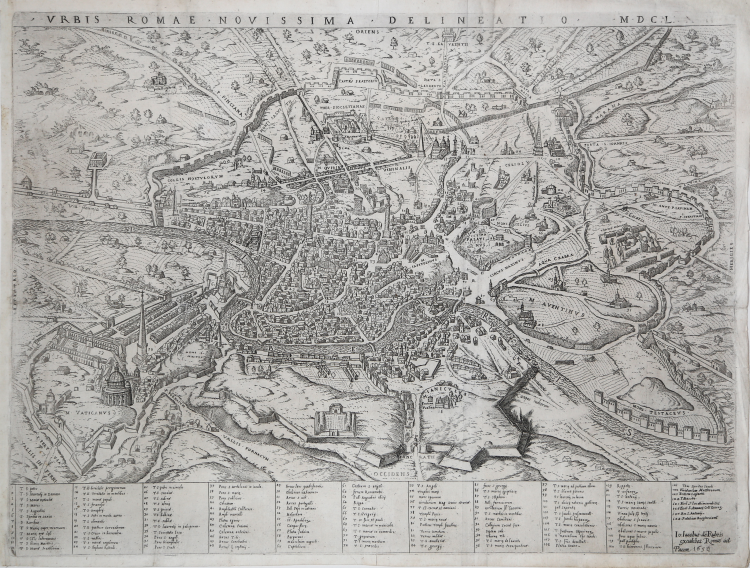



| Reference: | S40344 |
| Author | Giovanni Battista de’ CAVALIERI |
| Year: | 1589 |
| Zone: | Rome |
| Printed: | Rome |
| Measures: | 530 x 400 mm |


| Reference: | S40344 |
| Author | Giovanni Battista de’ CAVALIERI |
| Year: | 1589 |
| Zone: | Rome |
| Printed: | Rome |
| Measures: | 530 x 400 mm |
Perspective plan of the city from the Janiculum Hill, based on the model of the small Cartaro map (1575).
The work is attributed for the first time to Giovan Battista de Cavalleris S. Bifolco-F. Ronca, "Cartografia e topografia italiana del XVI secolo. Catalogo ragionato delle opere a stampa" (2018), that mention the only known copy of the first edition of the map, signed by Cavalleris and kept in the National Library of Malta. Previously, the work was known only through the reprint of Giuseppe de Rossi, dated to 1622, but clearly deriving from an earlier copper. There are numerous corrections of the slab, especially in the area of St. Peter's Basilica, via della Lungara and via Sistina, as well as in the area where the publisher's address is affixed.
Hülsen declares that he does not know the 1622 edition and therefore, not being able to establish whether it was a reprint of an antecedent plant, he describes it as "the de Rossi map". Marigliani (2007) ascribed the work to Ambrogio Brambilla, dating it to 1589. It is based on the fact that the Vatican Library in the Belvedere is not yet represented, completed at the end of 1589 and present in the other plant of Brambilla, edited by the heirs Duchetti in 1590. On the other hand, there is the obelisk erected in Piazza del Popolo at the beginning of 1589. Marigliani, moreover, underlines that in fact this is the first plant to depict the urban changes promoted by Sixtus V, thus covering a considerable importance historical.
The map shows the Sistine project, never realized by popular will, of a road that crossed the Colosseum. The map was reprinted in 1637, again signed by Giuseppe de Rossi. The legend is expanded to 128 numbers and the city walls near Porta Portese are clearly modified. The last known issue (our example)is reprinted by Gian Giacomo de Rossi in 1650.
Etching and engraving, signed in the plate at the bottom right. Exemple in the 4th state, with the signature of the editor de Rossi and the date 1650.
Along the upper margin we read the title: URBIS ROMAE NOVISSIMA DELINEATIO M.D.CL.. Below we find a numerical legend of 128 references, distributed on eleven columns. Orientation on all four sides in the center with the name of the cardinal points: SEPTENTRIO, MERIDIES, ORIENS, OCCIDENS, the north is on the left.
A good impression, printed on contemporary laid paper with watermark "anchor in the circle with star", with margins, small tear restored in the left side, for the rest very good condition.
Bibliografia
S. Bifolco-F. Ronca, Cartografia e topografia italiana del XVI secolo, pp. 2410-2411, tav. 1240, IV/IV; Ganado (1994): VI, p. 206, n. 101; Frutaz (1962): n. CL e tav. 333; Hülsen (1915): XIIc, p. 64, nn. 66-68; Hülsen (1933): p. 108, XIIc; Marigliani (2005): p. 128; Marigliani (2007): nn. 93, 110; Rocchi (1902): cfr. p. 75 e tav. XV; Scaccia Scarafoni (1939): p. 102, n. 189.
Giovanni Battista de’ CAVALIERI (1525-1601)
|
Engraver,printer and print publisher,from Villa Lagarina near Trento.Active in Venice and from 1559 in Rome.1577 he had a bottega in Parione which he let out to a cartolaio,Girolamo Agnelli. His own house was in the vicolo di Palazzo Savelli, with a workshop next to it. He was the brother-in-law of Lorenzo Vaccari.
Made plates for Antonio Salamanca, Lafrery and Faleti.By 1560 he seems to have been publishing his own plates. He entered into partnerships for publishing: in 1567 with Perino Zecchini de Guarlottis and in 1576 with Lorenzo Vaccari .In 1577 he was employng a printer: Francesco Cornuti .He acquired old plates that he recut. He published plates by his contemporaries,including Cort.He himself engraved after works of many artists,including Cort.He himself engraved after works of many artists,including Francesco Salviati,Daniele da Volterra, Raphael, Michelangelo, Polidoro da Caravaggio, Livio Agresti and Baccio Bandinelli.He also made copies of earlier prints.His subject matter included the devotional topographical,antiquarian,didactic and ‘popular’.
He published a number of important series: the Pontificum Romanorum Effigies of 1580 and the Romanorum Imperatorum Effigies of 1583; the Ecclesiae Anglicanae Trophea of 1584; the Antiquarum Statuarum Urbis Romae, the first book of which was first published before 1561/2.
|
Giovanni Battista de’ CAVALIERI (1525-1601)
|
Engraver,printer and print publisher,from Villa Lagarina near Trento.Active in Venice and from 1559 in Rome.1577 he had a bottega in Parione which he let out to a cartolaio,Girolamo Agnelli. His own house was in the vicolo di Palazzo Savelli, with a workshop next to it. He was the brother-in-law of Lorenzo Vaccari.
Made plates for Antonio Salamanca, Lafrery and Faleti.By 1560 he seems to have been publishing his own plates. He entered into partnerships for publishing: in 1567 with Perino Zecchini de Guarlottis and in 1576 with Lorenzo Vaccari .In 1577 he was employng a printer: Francesco Cornuti .He acquired old plates that he recut. He published plates by his contemporaries,including Cort.He himself engraved after works of many artists,including Cort.He himself engraved after works of many artists,including Francesco Salviati,Daniele da Volterra, Raphael, Michelangelo, Polidoro da Caravaggio, Livio Agresti and Baccio Bandinelli.He also made copies of earlier prints.His subject matter included the devotional topographical,antiquarian,didactic and ‘popular’.
He published a number of important series: the Pontificum Romanorum Effigies of 1580 and the Romanorum Imperatorum Effigies of 1583; the Ecclesiae Anglicanae Trophea of 1584; the Antiquarum Statuarum Urbis Romae, the first book of which was first published before 1561/2.
|